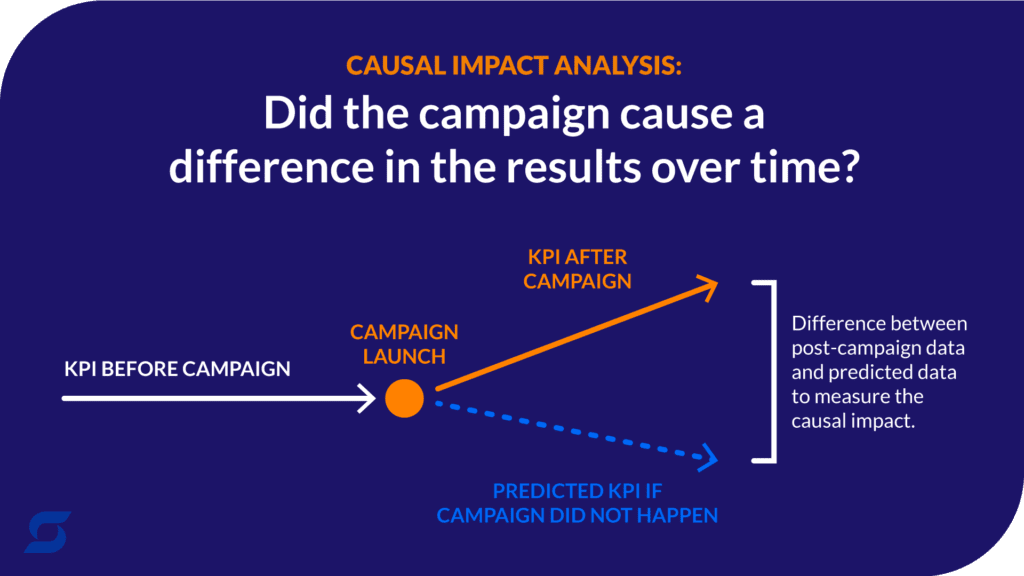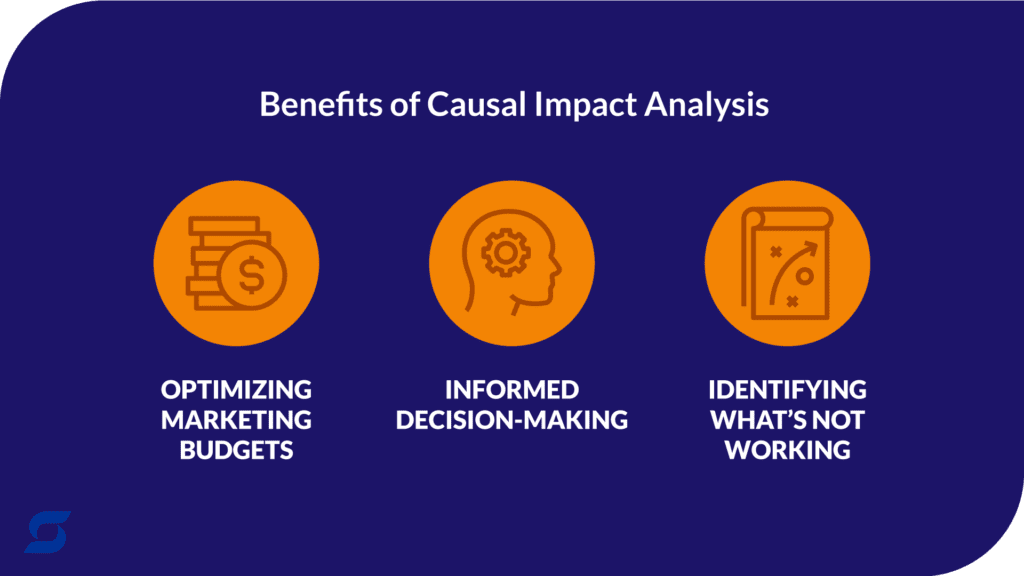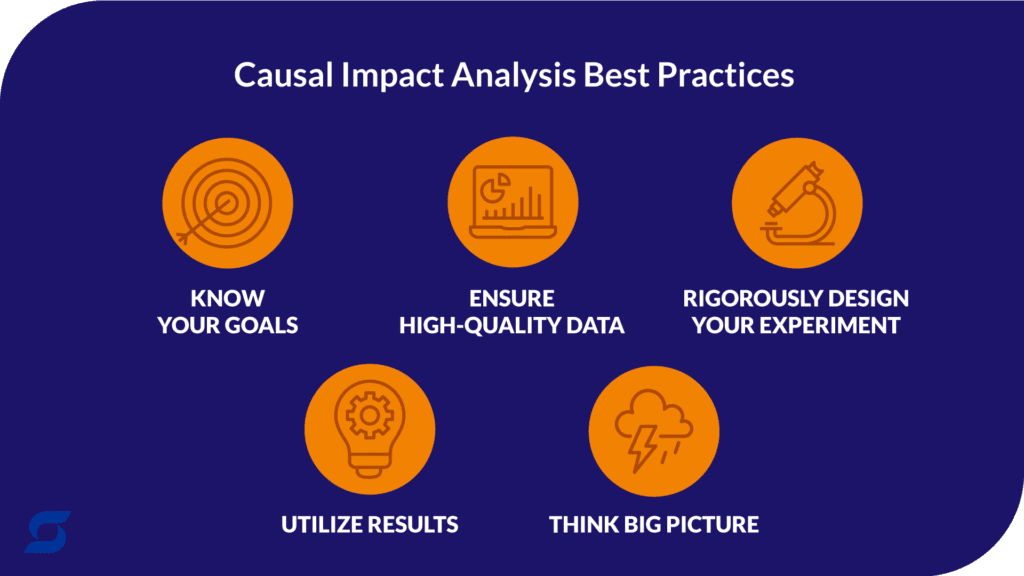In the fast-paced world of business, innovation and adaptation are key. And the role of a CEO extends far beyond traditional leadership. Today’s CEOs must retain a keen understanding of the competitive landscape, especially in the advertising space.
In today’s marketing landscape, consumers are constantly bombarded with messaging and ads. But what’s working? What are they paying attention to? What actions are they taking?
Understanding the true impact of your marketing through data and analytics is more important than ever. That’s where causal impact analysis comes in. This data-driven method gives you valuable insights into how your marketing campaigns influence actual business outcomes.
Did the campaign increase website traffic? Did it drive leads? Once you know the answers, you can optimize and make informed decisions that drive revenue growth and business expansion.
Let’s explore what causal impact analysis is, why it matters in marketing, and how it can offer a competitive advantage for your business.
What is Causal Impact Analysis?
In the real world of marketing, there are many cases where the only data we have is the result of our test. We don’t know what would have happened if there was no intervention at all.
Causal impact analysis seeks to answer one main question. Is there an impact of an intervention or action on the data that has been measured throughout time? In other words, did the change we made cause a difference in our results over time?
Causal impact analysis can be looked at like a very sophisticated version of an A/B test. But it also takes business results and time into account.
Unlike simple correlation analysis, causal impact analysis aims to establish a causal relationship between marketing efforts and business outcomes. This distinction between correlation and causation is essential. A correlation can show a relationship between two variables (such as a marketing campaign and a boost in leads). But it doesn’t prove that one causes the other.
For example, ice cream sales and sunglasses sales are positively correlated. But this doesn’t mean that buying sunglasses causes people to buy more ice cream. The correlation is likely due to warmer weather in the summer.
Measuring causation is tough because of the endless factors that can influence business outcomes. Market trends, seasonality, competitor activity, and world events can all affect sales, conversion rates, and other key performance indicators (KPIs). Traditional data analysis often fails to capture these complexities.
Causal impact analysis uses a Bayesian structural time series model to forecast the baseline values for the time period after an event.
These models account for various factors over time. They help isolate the true effect of a marketing campaign from other external influences. By doing so, causal impact analysis provides a more accurate and reliable measure of the impact of marketing.
Why Causal Impact Analysis Matters in Marketing
Causal impact analysis can answer critical questions for your marketing team, such as:
- What is the actual return on investment (ROI) of a recent marketing campaign?
- How do different marketing channels contribute to overall results?
- What would have happened if a particular campaign had not been implemented?
Understanding the true effects of marketing campaigns is vital for strategic planning and budgeting your ad spend. Just looking at the data alone might suggest that a campaign is successful based on an increase in sales.
Without causal impact analysis, though, it’s impossible to know if the sales were truly driven by the campaign or by other factors. Weather changes could have caused that bump in sales, or maybe it really was the campaign. Causal impact analysis provides the clarity needed to allocate resources effectively and optimize marketing strategies.
Benefits of Causal Impact Analysis
By answering those crucial questions, this method of analysis comes with some key benefits for your business:
Optimizing Marketing Budgets
By accurately measuring the impact of marketing efforts, you can allocate budgets more effectively. With reliable data backing your decisions, you strategically ensure that every dollar spent contributes to business growth.
Informed Decision-Making
Causal impact analysis provides data-driven insights that support strategic adjustments. Use it to help optimize marketing campaigns and improve conversion rates. If you know which campaigns had a true impact, you can take learnings into future efforts.
Identifying What’s Not Working
At the end of the day, you don’t want to be spending dollars that aren’t working. This analysis gives you those answers, so you can move on from ineffective campaigns or methods. Cutting out factors that aren’t working also inherently improves your customer experience.
Challenges and Considerations
Everything has its pros and cons. Implementing causal impact analysis in a marketing context comes with its challenges, as well. Some common pitfalls include:
Data Quality
Accurate and comprehensive data is essential for reliable analysis. Incomplete or biased data can lead to incorrect conclusions, undermining the entire process.
Ensuring data quality involves meticulous data collection and management practices. Businesses should invest in robust data infrastructure and consistently monitor data integrity. Addressing issues like data gaps, inaccuracies, or biases early on can significantly enhance the reliability of your analysis.
Setting Up the Experiment
To use causal impact analysis the right way, you need to set up controlled experiments that accurately measure the impact of marketing efforts.
Define clear objectives, select appropriate control groups, and ensure that the experimental conditions are as close to real-world scenarios as possible. Account for external factors like seasonality, market trends, and competitor actions for correct attributions of success or failure.
Careful planning and thorough documentation of the experimental design are crucial to isolate the true effects of marketing interventions.
Interpreting Results
Understanding and correctly interpreting the results of a causal impact analysis can be tricky. You must avoid common statistical errors, like overlooking confounding variables.
Analysts must consider external factors that might influence outcomes, such as economic shifts or unexpected events, and adjust models accordingly. This requires sophisticated technical expertise and a deep understanding of both statistical methods and the business context.
Leveraging your analytics team is crucial. Their insights and experience can help navigate the complexities and ensure accurate interpretation of results.
Overcoming Challenges
To overcome these challenges, businesses should follow best practices such as:
Know Your Goals
Before starting the analysis and experiment, clearly define what you hope to achieve. Identify a target variable that aligns with your objectives and helps you focus your analysis.
Ensure High-Quality Data
Ensuring high-quality data collection and management is crucial. Address issues like data gaps, inaccuracies, or biases early on to make your analysis more reliable and accurate.
Rigorously Design Your Experiment
A well-designed experiment is key for getting reliable results. Consult with data analytics experts to select and implement appropriate experimental designs that account for all relevant variables and conditions.
Utilize Results
Use the results from causal impact analysis to inform future marketing decisions. Continue testing if there are more questions. And treat the analysis as an ongoing resource for strategic decision-making, rather than a one-time activity.
Think Big Picture
Consider the broader environment when designing your experiments. Always be on the lookout for variables — like weather, political events, or economic factors — that could affect your analysis. Adjust your approach accordingly.
Conclusion
Causal impact analysis is essential for understanding the true effects of your marketing efforts, helping you distinguish causation from correlation. By optimizing budgets and making informed decisions, this method can enhance customer retention, improve operational efficiency, and drive business growth.
Like anything, there are challenges, like ensuring data quality and interpreting complex results. But partnering with analytics experts can help you harness the full potential of causal impact analysis. Embrace this tool to gain a competitive edge and foster data-driven decision-making.
Ready to transform insights into actionable strategies? Get in touch today to learn how our data team can drive growth and results for your business.









